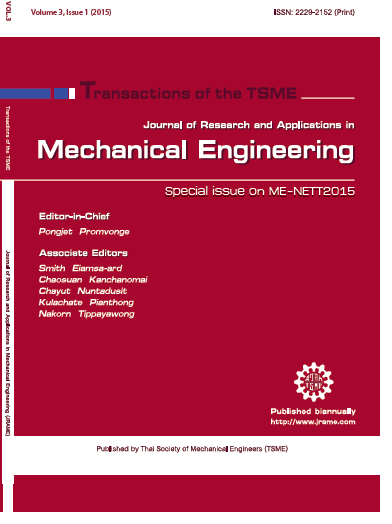Flow and mixing in a model swirl combustor equipped with a telescopic end plate porous medium
Main Article Content
Abstract
This paper reports an experimental investigation of a non-reacting turbulent swirl flow in a transparent model swirl combustor equipped with a telescopic end plate porous medium (PM), in an effort to design and developing a future combustion system based on a concept of a PM burner. Focus has been made on characterization and optimization of flow fields and mixing performance within the model combustor under various burner geometries, which are characterized by the number of tangential inlet Ninlet, inlet angle ø and the interdistance XPM between the telescopic end plate PM and the air inlet nozzle. PIV (particle image velocimetry) flow visualization technique is employed to study the flow fields and the mixing performance in terms of averaged turbulence intensity. The flow fields show, how the flow velocities and structures vary as
the controlling parameters vary. Based on the experimental results an optimum burner configuration is revealed. The relating parameters, in particular the telescopic end plate PM has a relatively large scale effect on flow fields and mixing phenomena.
Article Details
This work is licensed under a Creative Commons Attribution-NonCommercial-ShareAlike 4.0 International License.
References
[2] Chigier, N.A. and Chervinsky, A. Aerodynamic study of turbulent burning free jets with swirl, paper presented in the 11th Symposium (International) on Combustion, The Combustion Institute, 1967, pp. 489-499.
[3] Gupta, A.K., Lilley, D.G. and Syred, N. Swirl Flows, ISBN: 0-85626-175-0, 1984, Abacus Press, Cambridge, Massachusetts, USA.
[4] Jugjai, S., Wongpanit, N., Laoketkan, T. and Nokkaew, S. Experimental study on combustion of liquid fuels by a porous medium, Experimental Thermal and Fluid Science, Vol. 26(1), 2002, pp. 15-23.
[5] Jugjai, S. and Polmart, N. Enhancement of evaporation and combustion of liquid fuels through porous media, Experimental Thermal and Fluid Science, Vol. 27(8), 2003, pp. 901-909.
[6] Jugjai, S. and Pongsai, C. Liquid fuel-fired porous burner, Combustion Science and Technology, Vol. 179(9), 2007, pp. 1823-1840.
[7] Jugjai, S. and Phothiya. C. Liquid fuel-fired porous combustor-heater, Fuel, Vol. 86(7-8), 2007, pp. 1062-1068.
[8] Beer, J.M. and Chigier, N.A. Combustion aerodynamics, ISBN: 0-85334-513-9, 1972, Applied Science, London.
[9] Farokhi, S., Taghavi, R. and Rice, E.J. Effect of initial swirl distribution on the evolution of a turbulent jet, Journal of American Institute of Aeronautics and Astronautics, Vol. 27(6), 1989, pp. 700-706.
[10] Toh, I.K., Honnery, D. and Soria, J. Axial plus tangential entry swirling jet, Experiments in Fluids, Vol. 48(2), 2010, pp. 309-325.
[11] Shtork, S.I., Cala, C.E., Fernandes, E.C. and Heitor, M.V. Coherent helical structures in swirl flows, Technical Physics Letters, Vol. 31(8), 2005, pp. 660-662.
[12] Huang, Y. and Yang, V. Effect of swirl on combustion dynamics in a lean-premixed swirl-stabilized combustor, Proceedings of the Combustion Institute, Vol. 30(2), 2005, pp. 1775-1782.



